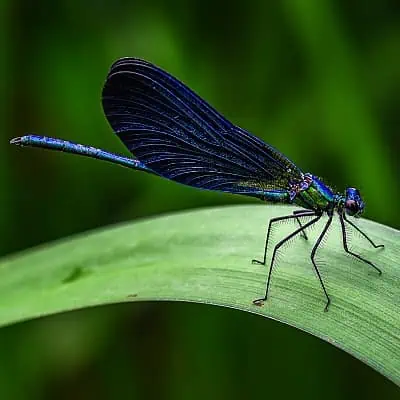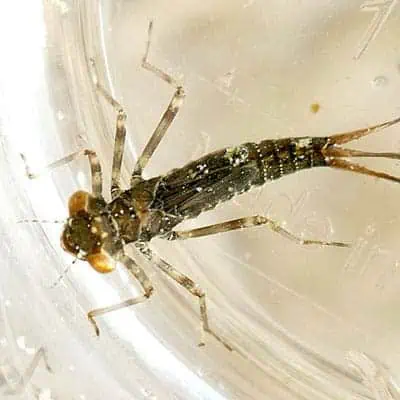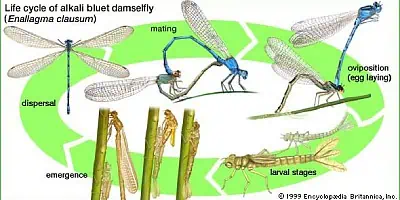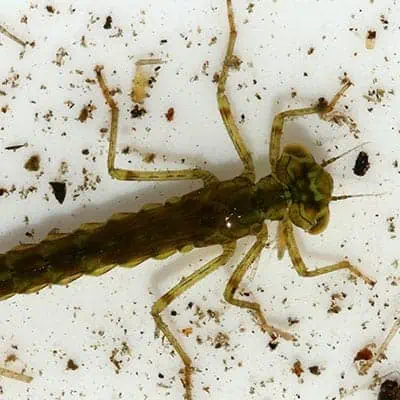
Damselflies belong to the order Odonata, which is known to contain incredibly prehistoric organisms that have been around since the Permian period (think of those pictures of eagle-sized dragonflies that you likely were equal parts fascinated and terrified by as a child). As evidenced by the previous statement, dragonflies can also be found in this order.
However, while damselflies and dragonflies look quite a lot alike, they belong to different suborders – damselflies are in Zygoptera, while dragonflies are in Anisoptera.
The most noticeable difference lies in how each organism holds their wings – dragonflies hold theirs out and to the side, while damselflies hold theirs together above their back. Damselfly bodies are also much more slender than that of dragonflies, oftentimes around half the circumference of the latter.
Within Zygoptera, there are over 20 families (the exact number is contested due to newly emerging molecular data) that amount to around 3,000 different species of damselflies! Perhaps the most well-known families (or rather, the most easily recognizable by most people, even those not particularly enthralled by insects) are Calopterygidae (broad-winged damselflies) and Coenagrionidae (narrow-winged damselflies).
Also known as the jewelwings, those in Calopterygidae can have strikingly brightly colored bodies, often cobalt or emerald, that seem to shimmer in the sun, and black or very dark wings, though not all species present this way. Coenagrionidae are also known as the pond damselflies, and is the most commonly encountered family worldwide, containing some of the smallest species, often with curved abdomens or tails and very thin wings.
Damselfly Habitats – Where Do They Live?

As adults, damselflies can be found flying about in riparian forests, forests with regularly damp soils, occasionally plains, and near ponds, streams, rivers, lakes, and really any water body. Water is required for reproduction, so they’re typically not far from a source. This brings us to the nymphs (larvae), which are found exclusively in the water, often hiding under rocks and in plants, but they can sometimes be seen darting about as they hunt. Dragonflies hatch in water and remain there until their final molt in which their wings become fully developed and they are able to permanently leave the water.
The wing design and size of damselflies is somewhat malleable, depending on habitat. Studies have found that damselflies found in plains habitats, such as prairies and pastures, tend to have overall larger wings enabling longer flights. This is presumably to allow them to fly greater distances in search of water. Damselflies found in forested habitats tend to have overall shorter wings, likely due to not having to fly as far to find water sources.
Damselflies are very pollution intolerant. As such, increasingly polluted waters worldwide, habitat loss, and climate change are the greatest threats to damselflies, as they absolutely cannot breed without clean water. In Poland, damselflies are being studied as bio-indicators of environmental pollution and integrity. Currently, populations are considered stable, but worldwide they’re not as numerous as they were even just a decade ago.
What do Damselflies Eat? (Damselfly Diet)

Damselfly larvae and adults alike are highly predatory, feeding on both adult and larval flies and mosquitoes, as well as gnats, moths, and other small flying insects, beetles, and occasionally bees and even caterpillars. This makes them a very desirable species to gardeners and ponders alike, as they help to keep pest insect populations in check.
Damselfly larvae are most often ambush predators, preferring to hide among plants and substrate until a potential target draws near. Their jaws are able to extend, and when prey is near they rush outward and scoop upward, grabbing prey quite adeptly while piercing them with tiny teeth. Their strong mandibles then make quick work of the meal.

As adults, damselflies catch prey during flight with their legs, the hairs of which help ensnare the victim. The damselfly will then use its toothed mandibles to tear them apart, either during flight or after landing.
Damselflies are a highly ecologically important species, beneficial in nature as well as commercially. They feed on a large variety of pest insects, including larval and adult mosquitoes, flies, and gnats. Damselfly nymphs and adults also provide a valuable food source for fish, frogs, turtles, and birds.
Are Damselflies Dangerous or Poisonous?
Damselflies are not considered dangerous to humans, fish, or pets. Whether aquatic larvae or flying adults, their mouthparts simply are not capable of harming our skin, nor do they try to go after things larger than they are. They’re not known to be toxic, either, so the larvae actually make a beneficial and protein packed food source for any fish that decide to eat them.
The Life Cycle of Damselflies

Damselflies can spend anywhere from two months to three years as nymphs, depending on environmental conditions. Without adequate food or in the presence of water that’s too cold, their life cycle will slow and they’ll remain stuck in their same larval stage for as long as is needed until conditions improve. As larvae, damselflies go through up to 15 different molting stages to accommodate growth until they reach adulthood.
The final stage involves the nymph, also known as a naiad, crawling out of the water and onto a plant or rock. It spends anywhere from a few minutes to a few hours sunbathing, drying out its skin until it cracks open to reveal an adult damselfly. Within a couple of hours, its legs have hardened and its wings have unfurled, allowing it to fly, which it promptly does to sate its newfound ravenous appetite.

Typically within a few days (or sometimes weeks) of achieving its adult molt, the damselfly will begin searching for a mate near water. This can occur anytime from spring through the height of summer. Males use the end of their tail to clasp onto the back of the females head during flight, and the female then curls her tail beneath herself and attaches it to the portion of his abdomen where he has deposited sperm.
They’ll fly about like this (or land) for several minutes before detaching. The female lands on the water and lays her eggs directly in plant tissues, sometimes submerging herself to do so. Males often stick around and guard the eggs until they hatch several days later.
Adults can live up to 6 months. Eggs and larvae that are still around going into winter can exist unharmed in ice for several months, completely encased. Adults, however, are not winter hardy and will die unless they live in a tropical region.
How to Attract Damselflies to Ponds:

Damselflies are very sensitive to pollution, so keeping a clean pond free of any pollutants like heavy metals or ammonium is key. There’s no set size requirement, so long as you have clean water and a mix of submerged, floating, and emergent plants. These plants will help to filter and oxygenate water, making it more desirable to damselflies.
In addition, plants will provide damselfly adults with a place to land, and also a place to lay their eggs since they are exclusively laid inside of plant tissues to help protect and nurture the larvae. Nymphs will also use these plants to help hide themselves, both for protection and for hunting prey. Adding some plants along the border of your pond doesn’t hurt either, particularly flowering plants that will help draw in prey species like flies and moths.
Having a few rocks sitting partially out of the water will also be appealing to damselflies, as they’ll be attracted to their warmth as a nice location for sunning and resting. They don’t mind some water movement, so long as they are able to land on plants and rocks. However, larvae need either slow-moving water or rocks to hide under or behind to get away from currents. With this in mind, opting for a slower, less powerful pump and skimmer will maximize your chances of attracting and keeping damselflies.
Are Damselflies or Damselfly Larvae Beneficial to Ponds?
Overall, damselflies are not harmful to you, your fish, or your pond. Though they have toothed mouthparts, these are not capable of harming fish or humans, nor will they try as they typically don’t attack prey larger than themselves.
Damselflies will never overtake your pond, nor will they harm your fish or plants, despite laying eggs in the plant tissues. Some fish may eat the larvae, as will birds, frogs, lizards, salamanders, and turtles, making them a valuable species to have around if you’re trying to encourage more wildlife presence at your pond. As an added bonus, damselfly adults and larvae feed on a variety of insects, most notably mosquitoes.

